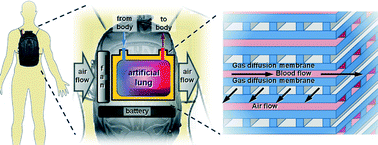The promise of microfluidic artificial lungs
Abstract
Microfluidic or microchannel artificial lungs promise to enable a new class of truly portable, therapeutic artificial lungs through feature sizes and blood channel designs that closely mimic those found in their natural counterpart. These new artificial lungs could potentially: 1) have surface areas and priming volumes that are a fraction of current technologies thereby decreasing device size and reducing the foreign body response; 2) contain blood flow networks in which cells and platelets experience pressures, shear stresses, and branching angles that copy those in the human lung thereby improving biocompatibility; 3) operate efficiently with room air, eliminating the need for gas cylinders and complications associated with hyperoxemia; 4) exhibit biomimetic hydraulic resistances, enabling operation with natural pressures and eliminating the need for blood pumps; and, 5) provide increased gas exchange capacity enabling respiratory support for active patients. This manuscript reviews recent research efforts in microfluidic artificial lungs targeted at achieving the advantages above, investigates the ultimate performance and scaling limits of these devices using a proven mathematical model, and discusses the future challenges that must be overcome in order for microfluidic artificial lungs to be applied in the clinic. If all of these promising advantages are realized and the remaining challenges are met, microfluidic artificial lungs could revolutionize the field of pulmonary rehabilitation.



 Please wait while we load your content...
Please wait while we load your content...